A common word in gardening this decade is ‘sustainable’; sustainable gardening is using the principles of ecological wisdom. When planting and puttering in my garden, which is two acres planted with CA natives, Mediterranean plants close to the house and natural groomed forest beyond, I think of this. How do I also create a long lasting garden? What will happen to my garden, when I can do less for it, or …nothing.
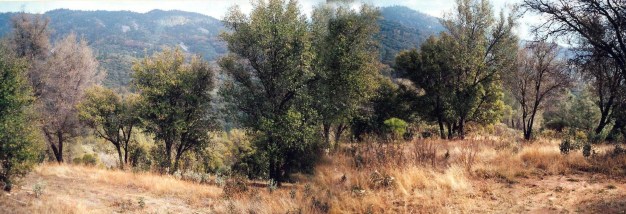
Oct 2000- Looking from where the house would soon stand; what we started with. Notice poison oak whips in foreground. Click to enlarge and you can see what we’re talkin’ ’bout here!
Natural and safe
The forest land here was the reason to come and we like it natural. Walking around with the real estate agent and later with our friends, we took in the scratchy oak trees, brushy to the ground snarled with what was poison oak about the base of each one. As we walked, my eyes lifted to the pines and to the mountain, giving me inspiration and courage. Russ asked, “Do you know that the branches you’re holding onto are poison oak?” I gave him a stricken look and pushed on up the hill to scrub my hands and arms to the wrists.
For five years, while we were waiting until time to build the house, we slowly eradicated the poison oak by cutting it and spraying any new sprouts every time we saw it. Spraying with aa systemic herbicide is controversial, but practical for poison oak, when you do it responsibly, to make a large property safe to work and play in.
Poison oak spreads through underground root systems, surrounding each tree in a ten foot radius. It also grows in three to four foot whips uniformly, a foot or two apart, between each tree in the manzanita groves. Our method was to cut it away around each tree, burn it, and spray the next spring when we saw the sprouts, always on a windless day. After ten years, we only see a few sprouts. If not for this maintenance, would it again take over? Probably, faster than I think.

Native landscape, thinned for fire safety. Trees and brush are thick over the fence line on left. Photo by Ken Wyatt
Groom for fire safety, while protecting trees.
When we first arrived we couldn’t see farther down than a twenty five yards down the slope, but every year we have been able to clear out around each tree, ten feet up and ten feet around, saving a few manzanitas underneath. Manzanitas are reputed to be so flammable, but after some research and reading how tests were done by the CDF, I found that they burn as fast, or slow, as scrub oak and pine. We’re talking about the difference between one and two minutes more flammable.
The previous owner, in order to clear the land for sale had simply bulldozed the brush down the slope, leaving huge piles of manzanita and scrub oak and poison oak. We have smoothed out most of those piles and cleared ten feet around and ten feet up into the tree, also removing dead branches. The effect will be long lasting and allows us to see the forest further down from our house, a view we love.
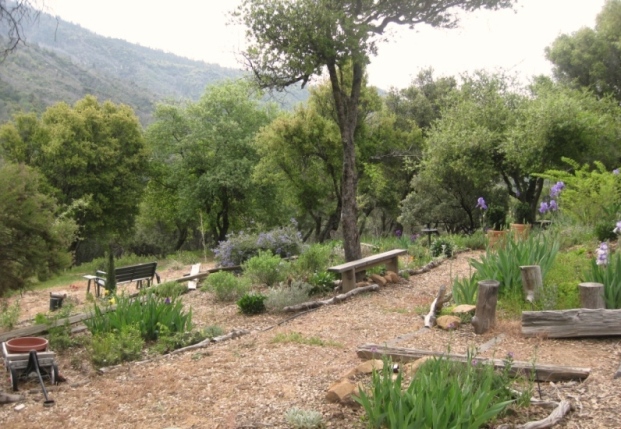
Three levels, from right, cultivated Mediterranean and native plants, below path, introduced natives and beyond the bench, natural
Save the natives; plant compatible plants along side
Close to the house we have had to clear away most of the manzanita, but I have saved a few to grow up in amongst the salvia, sulfur flowers and foothill penstamon. Using native plants in a garden can preserve and protect natural wildlife, and reduces the amount of time and energy required to maintain a long lasting garden. Natives were here when I came and if there is a time when I can no longer do as much upkeep they will go on, providing flowers in spring and their reddish brown sinewy trunks, peeling in the fall.
The oaks and pines are protected from irrigation and low water needs plants only are planted underneath and then only beyond the drip lines.

Groomed meadow. Yerba Santa, Eriodictyon crassifolium is trimmed, poison oak removed, deer grass added.
Protect and encourage wildlife
I don’t fertilize or spray for insects, allowing the natural process to work. I do provide water and seed or nectar to both birds and butterflies, but do so only close to the windows for my own enjoyment, knowing that the plants farther out will sustain wildlife when I don’t. Introducing additional CA natives will hopefully attract more species and are fun for me to plant and observe.
Sustaining the gardeners
Building the network of paths with benches along is another way to sustain the use of the garden and provide access for when we’re older. As we age, it will be easier to enjoy the garden safely, while getting our exercise. The paths are three to four feet wide, the width of the tractor scraper, and form large loops down the property behind the house and toward the view of the mountain to make several levels.
The paths wander through the trees and we have placed three benches, of the simplest kind, in different vantage points to get sun or shade or with a particular view. The benches are of 2” thick redwood landscaping lumber, found at the lumber store for half price for being ‘weathered’. Ask and ye shall find, I guess.
In the center of the garden, there is a lounge of rustic wood, cozied up with a pad, a quilt and pillows, to plop down on and rest. A small pedestal table held my book last summer and my glass of water. Sustaining, yes, and sustainable, too, as all these items were found in thrift shops, even the book, which is a collection of issues of “Garden Gate’ in a three ring binder.
Now when considering a sustainable garden, I am at peace, doing the best I can with what I learn and experience, and not worrying about tomorrow, …simply enjoying today.
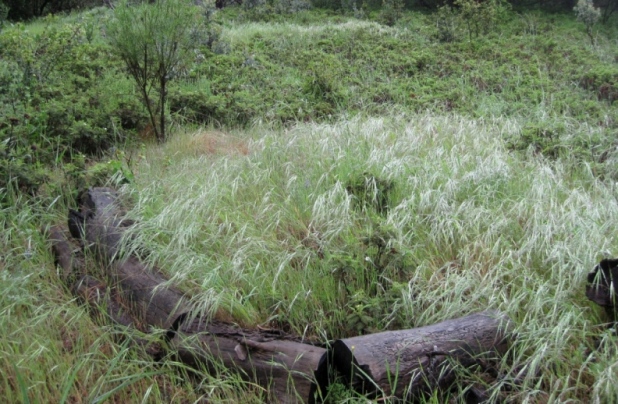
Removing weedy sprouts and placing a log edging around a grassy or wildflower patch neatens, but preserves the wildness.
Note on above photo: Hopefully, this is needlegrass. Bear clover, Chamaebatia foliolosa, is the ground cover behind, with the taller Goldenfleece, Ericameria arborescens, at right.

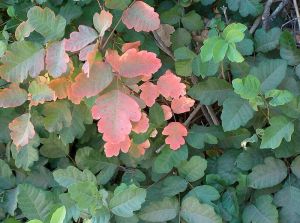
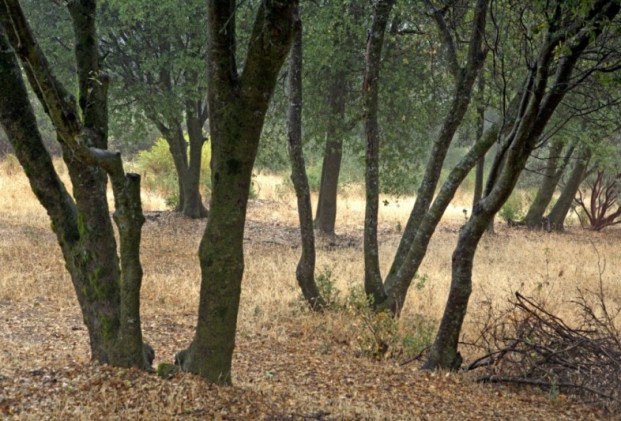
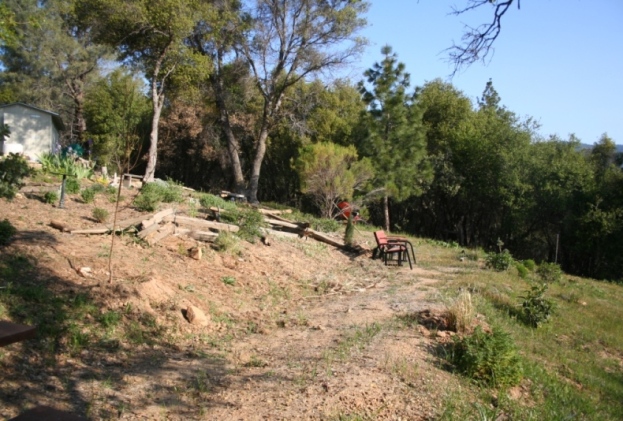

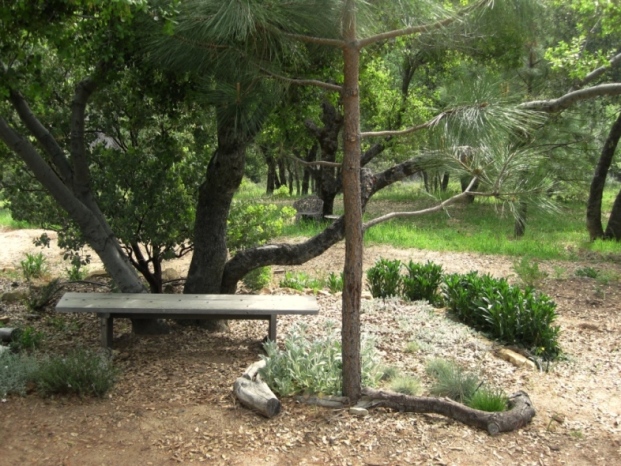
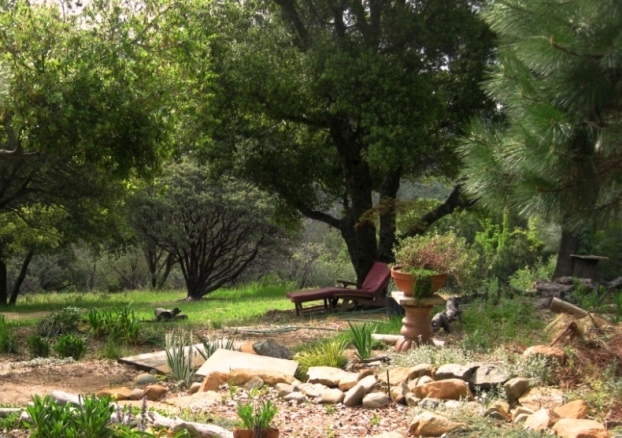
10 comments